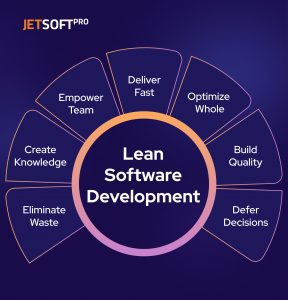Lean software development is all about working smart and implementing waste reduction principles, making it a game-changer in the world of software engineering. Coined as “Lean development” back in the early 1990s by Mary and Tom Poppendieck, who took inspiration from the Toyota Production System, this approach is all about being responsible in how we develop products, keeping an eye on both the environment and humanity. Supporters of Lean say that a hefty 30-40% of product development work is just wasteful and can be done better. By ditching unnecessary stuff, Lean development aims to ramp up efficiency, save time and resources, and make plans work like a charm.
Let’s delve into the seven fundamental principles of Lean software development and unravel how they contribute to creating resilient and efficient development processes.
- Eliminate Waste: Lean software development takes a hard stance against anything that doesn’t add value to the end product. This includes trimming unnecessary code, documentation, and cutting down on idle time between tasks. By implementing waste reduction, teams can channel their efforts into delivering features that truly matter, ultimately reducing development time and enhancing software quality.
- Create Knowledge: Continuous learning forms the backbone of Lean software development. Teams are encouraged to foster a culture of experimentation, learning from both successes and failures. This mindset shift prioritizes learning over finger-pointing, allowing developers to continually enhance their skills, adapt to changing requirements, and fine-tune their processes for better results.
- Empower Team: Empowering teams means giving them the autonomy and authority to make decisions that directly impact their work. In Lean software development, recognizing the importance of a motivated and self-organizing team is key. When team members feel ownership and are empowered to collaborate and innovate, the overall efficiency and effectiveness of the development process flourish.
- Deliver Fast: Lean software development is all about delivering software quickly and efficiently. It supports the rapid and incremental release of software, ensuring that small, functional increments are delivered regularly. This not only accelerates time-to-market but also enables agile adjustments to the software based on evolving user needs and market dynamics. The focus here is on enhancing software development efficiency by delivering valuable updates in a timely and responsive manner.
- Optimize Whole: Lean software development urges a comprehensive view of the development process. Instead of fine-tuning individual components or teams in isolation, the focus is on optimizing the entire value stream. This entails identifying and addressing bottlenecks, inefficiencies, and dependencies across the entire development lifecycle, resulting in a seamless and efficient workflow.
- Built Quality: Building integrity into the software development process involves prioritizing quality from the outset. Rather than relying on extensive testing and bug fixes post-development, Lean principles advocate for a proactive quality assurance approach. Practices like pair programming, automated testing, and continuous integration ensure that defects are caught early in the development cycle.
- Defer Decisions: The Lean mantra encourages making decisions at the last possible moment, armed with the most pertinent information. This approach minimizes the risk of premature decisions based on incomplete or inaccurate data, ensuring that teams make well-informed choices that align with evolving project requirements.
Exploring the Symbiosis of Lean Software Development and Agile Methodologies
Lean and Agile may seem like two peas in a pod, but there’s a bit of history between them. Lean came first, emphasizing the here and now, helping streamline processes by cutting costs. On the flip side, Agile is all about flexibility, teaching us to adapt fast to the changes and keeping our eyes on the prize – the final product. To figure out how these two principles can team up effectively, let’s take a closer look at what sets them apart.
Let’s break down the key differences:
#Approach to Change:
- Lean: Takes a careful approach to change, aiming to minimize disruptions.
- Agile: Embraces change, considering it a natural and essential part of the development journey.
#Customer Involvement:
- Lean: Values customer input but might not actively seek it throughout the entire development cycle.
- Agile: Places a high priority on continuous customer collaboration, ensuring their feedback is consistently integrated.
#Process Optimization:
- Lean: Focuses on optimizing the entire value stream, identifying and eliminating bottlenecks.
- Agile: Optimizes individual iterations, concentrating on adapting to changes swiftly.
#Decision-Making Timing:
- Lean: Delays decisions until the last responsible moment, relying on the most relevant information.
- Agile: Urges quick decision-making to facilitate speedy progress.
Now, imagine blending these two approaches – Lean thinking and Agile methodology. They each bring something special to the table, and when you blend them, magic happens. Here’s why this combo usually brings top-notch results:
- Flexibility Meets Efficiency: Imagine Lean’s efficiency principles and Agile’s flexibility coming together like a power duo. Picture Lean, with its roots in streamlining manufacturing processes to cut waste and enhance efficiency. On the flip side, Agile is all about staying nimble and responding quickly to changes. When these two join forces, they create a dynamic project management approach that’s quick on its feet and responsive to whatever comes its way. It’s like the best of both worlds working hand in hand.
- Continuous Improvement and Iterative Progress: The continuous improvement mindset of Lean, combined with Agile’s iterative approach, creates a development cycle that consistently evolves toward perfection. The iterative cycles of Agile development provide opportunities for regular feedback and adjustments, ensuring that each iteration contributes to the overall enhancement of the project. This continuous learning and refinement lead to a development cycle that is in a constant state of evolution towards perfection.
- Customer-Centric Development: Agile’s customer-centric approach, which prioritizes customer feedback and involvement throughout the development process, complements Lean’s commitment to delivering value. This collaboration ensures that the end product not only meets but often exceeds customer expectations. The iterative nature of Agile allows teams to incorporate customer feedback promptly, resulting in a product that resonates with the end users.
- Optimizing the Entire Value Stream and Iterative Cycles: Lean’s big-picture perspective, which looks at the entire value chain, complements Agile’s attention to detail in individual iterations. This harmonious combination enables teams to identify and address both macro and micro-level inefficiencies, resulting in a well-rounded and optimized development process.
How to start implementing Lean Approach in Your Company
Making the Lean approach work for your company might seem challenging if you’re new to these principles, but there are clear steps to get started:
- Streamline Processes: Reviewing and simplifying your processes is crucial for Lean implementation. Identify steps or components that do not contribute significantly to the project’s success and consider eliminating them. This helps in minimizing unnecessary efforts and resources.
- Organize Development Logic: Creating a clear layout for development logic ensures that everyone in the team understands the project’s structure and goals. Encourage collaborative planning sessions involving the entire team to foster a shared understanding. This approach not only enhances teamwork but also promotes a sense of ownership among team members.
- Avoid Overload: Overloading your development process with numerous tasks can lead to inefficiencies and reduced focus. Emphasize the importance of maintaining a manageable workload for the team. This helps in delivering higher-quality work by preventing burnout and enabling team members to concentrate on essential tasks.
- Optimize and Standardize: Optimization involves improving efficiency by eliminating redundancies and enhancing repetitive activities. Standardization, on the other hand, establishes consistent practices for various processes. For instance, having standardized presentation formats, report structures, and code formatting rules facilitates smoother collaboration and reduces the chances of errors.
- Support Your Team: Acknowledge that embracing changes and taking on additional work can be challenging for your team. Ensure clear communication about tasks, changes, and expectations. Identify and address any obstacles or concerns that team members might face during this transition. Building a supportive environment fosters a positive attitude towards Lean methodologies.
Implementing these changes will yield several positive outcomes:
- Faster Product Implementation: By streamlining processes and reducing unnecessary steps, the time required to bring a product to market significantly decreases. This agility is a key advantage in today’s fast-paced business environment.
- Holistic Project Approach: Encouraging a holistic mindset within your development team promotes a comprehensive understanding of the project’s goals and encourages collaborative problem-solving. This approach ensures that each team member sees the broader picture, contributing to more cohesive and successful projects.
- Reduced Revisions, Improved Quality: Streamlining processes and maintaining a clear focus on tasks contribute to a reduction in the number of revisions required. Additionally, the emphasis on quality and efficiency ensures that the end product is of higher quality, meeting or exceeding customer expectations.
By embracing Lean principles and incorporating them into your development process, you’re not just optimizing for efficiency; you’re creating an environment that fosters innovation, collaboration, and continuous improvement.



